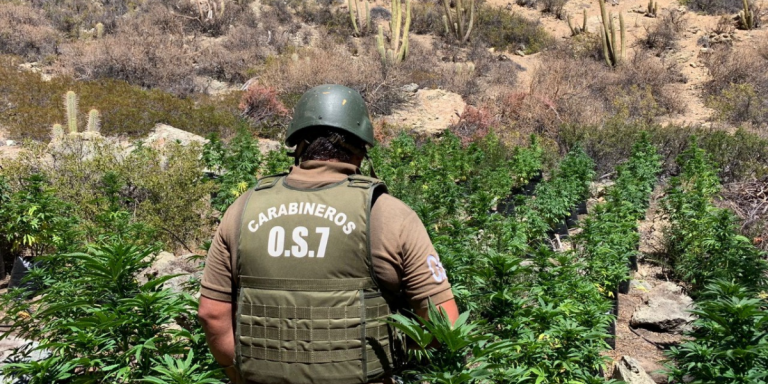Chilean authorities have discovered numerous marijuana plantations in the mountainous regions of central Chile. In the first two months of the year, authorities seized 82,906 plants and 1.2 tons of processed drugs, the Chilean Investigative Police (PDI) said in a March 11 report on Plan Cannabis 2022.
The findings indicate that Chile is no longer just a major destination for cannabis, but also a producer, organize crime experts warn. “Large-scale marijuana cultivation in Chile indicates that domestic production is becoming an alternative to importing cannabis to supply the country’s lucrative local market,” reported InSight Crime, an organization that specializes in organized crime in Latin America and the Caribbean.

The latest seizure of marijuana farms occurred in mid-March, when police officers seized some 8,600 plants. The operation took place in the Las Mollecas sector, in the interior of the commune of Canela, Choapa province.
“The operation was described as ‘historic’ for the area, since it is the first discovery of cannabis in the commune of Canela,” reported Chilean newspaper La Tercera. “Lieutenant Manuel Riquelme, from the Los Vilos sub-commissariat, said that thanks to the operation ‘we’ve avoided the commercialization of more than 10 million doses,’” La Terceraadded. The plantation had an irrigation system to minimize the effects of the region’s drought.
In March, Police from the OS-7 Aconcagua Section found a cannabis plantation with 4,126 plants in the Cabildo district. “Eight artisanal fields were seized with cannabis plants in the growing process, with a hose and drip irrigation system, supplied by a water collection pool,” Captain Juan Guzmán, head of Carabineros OS-7 Aconcagua, told Chile’s El Observador newspaper.
The largest seizure occurred in February, when the PDI destroyed 27,000 marijuana plants in Coquimbo, reported Chile’s El Diario de los Vilos.
Marijuana boom
Cannabis production in Chile reflects changes in the dynamics of narcotrafficking in South America. For many years, the marijuana consumed in Chile was imported from Paraguay and Bolivia. The market then began to be appropriated by the potent marijuana trafficked from Colombia.
“However, marijuana smuggling became much more difficult after the closure of land borders due to the COVID-19 pandemic, so some criminal groups opted for maritime routes,” InSight Crime said. “Local cannabis production also helped fill the void.”
The downward trend in the influx of marijuana from Paraguay started before the pandemic. Between 2016 and 2019, marijuana seized “on the Paraguay-Argentina/Bolivia-Chile route fell by 900 percent,” according to the 2020 Report of the Chilean Public Ministry’s Drug Trafficking Observatory.
The structure of domestic marijuana production also changed. Before the pandemic, the activity involved small local growers. Now plantations use commercial farming techniques to increase production, InSight Crime said.
“Today we see that these ‘narco-farmers’ have been associating mainly in family clans where they have been forming a kind of cooperative,” Felipe Molina, deputy commissioner of the PDI’s Metropolitan Anti-Narcotics Brigade, told La Tercera. “[That] leads them to work together, allowing them to produce more drugs,” Deputy Commissioner Molina added.









